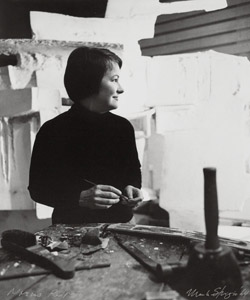Norma Redpath facts for kids
Quick facts for kids
Norma Redpath
|
|
|---|---|

Redpath in 1964, photographed by Mark Strizic
|
|
| Born |
Norma Redpath
20 November 1928 Melbourne, Australia
|
| Died | 12 January 2013 (aged 84) |
| Nationality | Australian |
| Education | Swinburne Technical College and Universita per Stranieri in Perugia |
| Known for | Sculpture |
|
Notable work
|
Treasury Fountain, Canberra |
| Movement | Centre 5 |
| Awards | OBE |
Norma Redpath OBE (20 November 1928 – 12 January 2013) was a very important Australian sculptor. She created amazing artworks, mostly sculptures, and worked in both Italy and her home city of Melbourne. Her art is known for its strong, modern shapes, often made from bronze.
Contents
Early Life and Learning
Norma Redpath was born on 20 November 1928. She started studying painting in 1942 at the Swinburne Technical College. After a long break due to illness, she switched to sculpture in 1949. She studied sculpture at the Royal Melbourne Institute of Technology. Norma mostly taught herself, as she didn't find much modern sculpture in Australia that interested her.
While still a student, she joined the Victorian Sculptors' Society. This group later became the Association of Sculptors of Victoria. She showed her work there and even became vice-president.
Her Sculpture Career
In 1952, Norma Redpath taught at the Korowa Anglican Girls' School and the Melbourne Technical College. Around this time, she also opened her very first sculpture studio. She paid for it herself.
Forming Art Groups
In 1953, Norma helped start a group called the "Group of Four." Other artists in this group were Inge King, Julius Kane, and Clifford Last.
During the 1950s, she traveled to Europe. From 1956 to 1958, she studied in Italy at the Universita per Stranieri in Perugia. This trip made her love Italy and its art even more.
In 1958, she came back to Australia to teach at Swinburne Technical College. She also became a founding member of another famous group called "Centre Five" in 1959. This group grew from the "Group of Four." They broke away from the Victorian Sculptors' Society and held their own art shows. In 1960, Norma was one of the artists chosen for the National Gallery of Victoria's Six Sculptors exhibition. This was the first time the gallery showed modern local sculptures.
Working with Bronze
By 1961, Norma decided to focus on bronze sculptures. Her plaster cast, Dawn figure, won the first Mildara Prize for Sculpture. In the same year, she won two important travel scholarships. These allowed her to continue her studies.
In 1962, she studied at the Accademia di Belle Arti di Brera in Milan, Italy. Milan became her base as she traveled between Italy and Australia. The sculptures she made there were shown in her Gallery A exhibition in Melbourne the next year. One of these sculptures won her a second Mildara Prize in 1964. In 1966, she won the Transfield Prize for Sculpture.
In 1968, she returned to Melbourne and set up her second studio in Parkville. Here, she worked on many big projects.
Later Years and Return to Australia
In 1974, while in Italy, Norma married Antonio de Altamer. He was an Italian naval architect. They worked together to improve how sculptures were made at foundries like Fonderia Artistica Battaglia. From the late 1970s, she stopped making physical sculptures. Instead, she wrote down her ideas in a book called Ideas and Images.
From 1974 to 1985, she lived and worked in both Milan and Melbourne. In 1985, she and her husband moved back to Australia for good. She opened her third Australian sculpture studio in Carlton. Her last art show was at the Heide Museum of Modern Art in 2000.
Awards and Recognition
In 1970, Norma Redpath was given a special award. She was appointed an Officer of the Order of the British Empire (OBE). This was for her great contributions to modern sculpture.
In 2006, her old college, now Swinburne University, gave her an honorary doctorate. This was a special degree to honor her achievements.
Legacy and Studio
Norma Redpath's husband passed away in 2000. She died in Melbourne in 2013 at the age of 84, after a long illness.
Her studio and home in Carlton are now owned by the University of Melbourne. It is managed by the Centre of Visual Art. Artists, writers, and researchers can stay there to create new work. They can also connect with other artists and workers in the area.
Selected Sculptures
- Areopagitica (1958), at the Baillieu Library, University of Melbourne.
- Bronze Reliefs (1964), originally at a BP building, now at the McClelland Gallery and Sculpture Park.
- Treasury Fountain (1965–1969), located at the Treasury Building in Canberra. This is a two-piece bronze fountain.
- Victoria Coats of Arms (1968), a bronze relief above the entrance of the National Gallery of Victoria, Melbourne.
- Sculpture Column (1969–1972), at the Reserve Bank of Australia in Brisbane.
- Facade Relief (1970–1972), on the Victorian College of Pharmacy building in Parkville, Melbourne.
- Sydney Rubbo Memorial Capital (1970–1973), in the Microbiology and Immunology Building Courtyard, University of Melbourne.
- Higuchi Sculpture (1971–1972), at the Monash University in Melbourne.
- Extended Column (1972–1975), at the Canberra School of Music, Canberra.
- Paesaggio Cariatide (Carrying the Landscape) (1980–1985), originally in Bourke Street, Melbourne. Since 2003, it has been at the McClelland Gallery and Sculpture Park in Langwarrin, Victoria.
Images for kids





